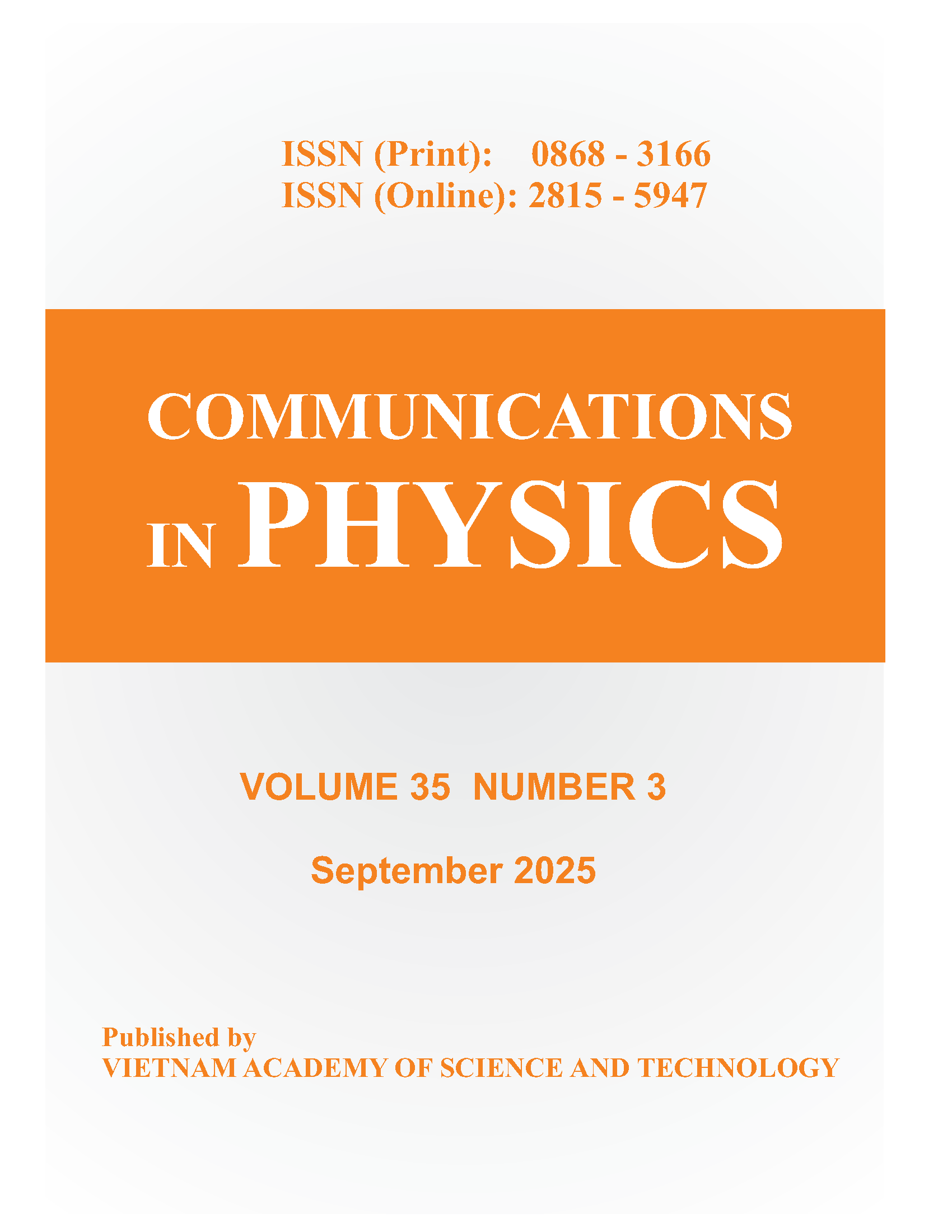Effect of bias voltage and carrier gas on the hydrogen gas-sensing properties of tungsten oxide nanobeads
Author affiliations
DOI:
https://doi.org/10.15625/0868-3166/15809Keywords:
WO3 nanobeads, I-V characterization, H2 gas sensing propertiesAbstract
We investigated the effect of bias voltage and carrier gas on the hydrogen sensing performance of tungsten oxide nanobeads. The tungsten oxide nanobeads were prepared by a template-assisted method followed by calcination. The porous single walled carbon nanotube thin film was used as sacrificed template for the deposition of tungsten, followed by thermal calcination at high temperature to oxidize W into WO3 and to burn out the template. The crystal structures and morphology of the synthesized materials were characterized by X-ray diffraction, field-emission scanning electron microscopy, high-resolution transmission electron microscopy and Raman spectra. Hydrogen gas sensing properties were tested in air and in N2 as refence for comparison. Our results indicated that Schottky junction was formed at the interface of WO3 and Pt electrodes. The sensor operated under revered bias voltage processed excellent hydrogen sensing performance. In addition, the H2 sensing performance of the WO3 nanobeads is higher when measured in N2 gas as reference.
Downloads
References
S.M. Kim, H.J. Kim, H.J. Jung, J. Park, T.J. Seok, Y. Choa, T.J. Park, S.W. Lee, High‐Performance, Transparent Thin Film Hydrogen Gas Sensor Using 2D Electron Gas at Interface of Oxide Thin Film Heterostructure Grown by Atomic Layer Deposition, Adv. Funct. Mater. (2018) 1807760. doi:10.1002/adfm.201807760.
V. Schröder, B. Emonts, H. Janßen, H.-P. Schulze, Explosion Limits of Hydrogen/Oxygen Mixtures at Initial Pressures up to 200 bar, Chem. Eng. Technol. 27 (2004) 847–851. doi:10.1002/ceat.200403174.
N. Van Duy, N.D. Hoa, N. Van Hieu, Effective hydrogen gas nanosensor based on bead-like nanowires of platinum-decorated tin oxide, Sensors Actuators B Chem. 173 (2012) 211–217. doi:10.1016/j.snb.2012.06.079.
B. Wang, L.F. Zhu, Y.H. Yang, N.S. Xu, G.W. Yang, Fabrication of a SnO 2 Nanowire Gas Sensor and Sensor Performance for Hydrogen, J. Phys. Chem. C. 112 (2008) 6643–6647. doi:10.1021/jp8003147.
Z. Li, Z. Yao, A.A. Haidry, T. Plecenik, L. Xie, L. Sun, Q. Fatima, Resistive-type hydrogen gas sensor based on TiO2: A review, Int. J. Hydrogen Energy. 43 (2018) 21114–21132. doi:10.1016/j.ijhydene.2018.09.051.
W. Li, N.D. Hoa, D. Kim, High-performance carbon nanotube hydrogen sensor, Sensors Actuators B Chem. 149 (2010) 184–188. doi:10.1016/j.snb.2010.06.002.
N.D. Hoa, S.A. El-Safty, Highly sensitive and selective volatile organic compound gas sensors based on mesoporous nanocomposite monoliths, Anal. Methods. 3 (2011) 1948. doi:10.1039/c1ay05333g.
N. Van Hieu, P. Thi Hong Van, L. Tien Nhan, N. Van Duy, N. Duc Hoa, Giant enhancement of H 2 S gas response by decorating n-type SnO 2 nanowires with p-type NiO nanoparticles, Appl. Phys. Lett. 101 (2012) 253106. doi:10.1063/1.4772488.
S. Mohd Chachuli, M. Hamidon, M. Mamat, M. Ertugrul, N. Abdullah, A Hydrogen Gas Sensor Based on TiO2 Nanoparticles on Alumina Substrate, Sensors. 18 (2018) 2483. doi:10.3390/s18082483.
A. Mirzaei, H.R. Yousefi, F. Falsafi, M. Bonyani, J.-H. Lee, J.-H. Kim, H.W. Kim, S.S. Kim, An overview on how Pd on resistive-based nanomaterial gas sensors can enhance response toward hydrogen gas, Int. J. Hydrogen Energy. 44 (2019) 20552–20571. doi:10.1016/j.ijhydene.2019.05.180.
J.-H. Kim, A. Mirzaei, H. Woo Kim, S.S. Kim, Combination of Pd loading and electron beam irradiation for superior hydrogen sensing of electrospun ZnO nanofibers, Sensors Actuators B Chem. 284 (2019) 628–637. doi:10.1016/j.snb.2018.12.120.
K. Yan, Y. Toku, Y. Ju, Highly sensitive hydrogen sensor based on a new suspended structure of cross-stacked multiwall carbon nanotube sheet, Int. J. Hydrogen Energy. 44 (2019) 6344–6352. doi:10.1016/j.ijhydene.2019.01.055.
Y. Kim, Y.S. Choi, S.Y. Park, T. Kim, S.-P. Hong, T.H. Lee, C.W. Moon, J.-H. Lee, D. Lee, B.H. Hong, H.W. Jang, Au decoration of a graphene microchannel for self-activated chemoresistive flexible gas sensors with substantially enhanced response to hydrogen, Nanoscale. 11 (2019) 2966–2973. doi:10.1039/C8NR09076A.
N.D. Hoa, V. Van Quang, D. Kim, N. Van Hieu, General and scalable route to synthesize nanowire-structured semiconducting metal oxides for gas-sensor applications, J. Alloys Compd. 549 (2013) 260–268. doi:10.1016/j.jallcom.2012.09.051.
N. Van Hieu, V. Van Quang, N.D. Hoa, D. Kim, Preparing large-scale WO3 nanowire-like structure for high sensitivity NH3 gas sensor through a simple route, Curr. Appl. Phys. 11 (2011) 657–661. doi:10.1016/j.cap.2010.11.002.
N.D. Hoa, N. Van Quy, Y. Cho, D. Kim, Porous single-wall carbon nanotube films formed by in Situ arc-discharge deposition for gas sensors application, Sensors Actuators B Chem. 135 (2009) 656–663. doi:10.1016/j.snb.2008.10.041.
D.Y. Lu, J. Chen, J. Zhou, S.Z. Deng, N.S. Xu, J.B. Xu, Raman spectroscopic study of oxidation and phase transition in W18O49 nanowires, J. Raman Spectrosc. 38 (2007) 176–180. doi:10.1002/jrs.1620.
T. Scheler, O. Degtyareva, M. Marqués, C.L. Guillaume, J.E. Proctor, S. Evans, E. Gregoryanz, Synthesis and properties of platinum hydride, Phys. Rev. B. 83 (2011) 214106. doi:10.1103/PhysRevB.83.214106.
K. Tsukada, H. Inoue, F. Katayama, K. Sakai, T. Kiwa, Changes in Work Function and Electrical Resistance of Pt Thin Films in the Presence of Hydrogen Gas, Jpn. J. Appl. Phys. 51 (2012) 15701. doi:10.1143/JJAP.51.015701.
Downloads
Published
How to Cite
Issue
Section
License
Communications in Physics is licensed under a Creative Commons Attribution-ShareAlike 4.0 International License.
Copyright on any research article published in Communications in Physics is retained by the respective author(s), without restrictions. Authors grant VAST Journals System (VJS) a license to publish the article and identify itself as the original publisher. Upon author(s) by giving permission to Communications in Physics either via Communications in Physics portal or other channel to publish their research work in Communications in Physics agrees to all the terms and conditions of https://creativecommons.org/licenses/by-sa/4.0/ License and terms & condition set by VJS.











